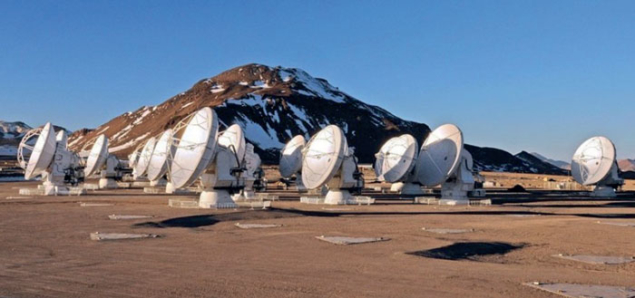
Image credit: ALMA (ESO/NAOJ/NRAO)/W Garnier (ALMA).
A team of astronomers using the Atacama Large Millimetre/submillimetre Array (ALMA) has identified sugar molecules in the gas surrounding a young Sun-like star. This is the first time that sugar has been found in space around such a star and the discovery suggests that the building blocks of life are available when planets form.
A long list of molecules has already been detected in the interstellar medium. They range from simple diatomic compounds such as O2 or CO to complex molecules, including alcohol or even fullerenes (C60 or “buckyballs”). The simple form of sugar found by ALMA is glycolaldehyde, H2COHCHO, a molecule that was first detected in 2000 in a big molecular cloud, Sagittarius B2, near the centre of the Galaxy. It has now been detected in a planet-forming disc around IRAS 16293-2422, a young binary star of about the same mass as the Sun. The star is located some 400 light-years away in the relatively nearby Rho Ophiuchi star-forming region.
Finding molecules in space requires an extremely precise spectrometer in the microwave range of the electromagnetic spectrum. The vibration and rotation of a molecule is quantized and so can take only certain fixed values. As in atomic de-excitation, the transition from one vibrational or rotational level to another with less energy results in the emission of a photon of the corresponding energy. This leads to an excess of photons at given energies resulting in characteristic emission-lines in the spectrum of a source.
The ALMA observatory – which saw “first light” a year ago – offers the high sensitivity and spectral resolution needed for such studies (CERN Courier November 2011 p13). The project is a partnership between Europe, North America and East Asia in co-operation with the Republic of Chile. Led by the European Southern Observatory (ESO) on behalf of Europe, it is the largest astronomical project in existence. When completed in 2013, ALMA will be a giant array of 66 antennae that can be moved in different configurations with a maximum extension of 16 km. Located in the harsh environment of the Chajnantor plateau in northern Chile, at 5000 m above sea level, it benefits from a dry and thin high-altitude atmosphere.
The emission lines corresponding to glycolaldehyde were discovered by a team of astronomers led by Jes Jørgensen of the Niels Bohr Institute, University of Copenhagen. The importance of the discovery lies in glycolaldehyde being one of the ingredients in the formation of ribonucleic acid (RNA) – a macromolecule similar to DNA – which is essential for life on Earth. Finding such complex molecules around a star at distances similar to the distance between Uranus and the Sun means that the building blocks of life exist around new-born stars at the time of planet formation.
There are two open issues linked to the finding. First, how do these complex molecules form? Second, can they survive planet formation? Random interactions of atoms floating in space would not be sufficient to explain the amount and complexity of molecules that have been found there. Dust grains are thought to be a favoured place where atoms could be ionized by cosmic rays and then combined with nearby atoms or molecules by electrostatic attraction. If these space-born molecules are to be considered as the seeds for life, then a means of protecting them from excessive heat and the ionizing ultraviolet radiation from the star during the chaotic process of planet formation needs to be understood. What is much more certain, is that ALMA is keeping its promises and will bring new clues to the origin of life on Earth and possibly elsewhere.







